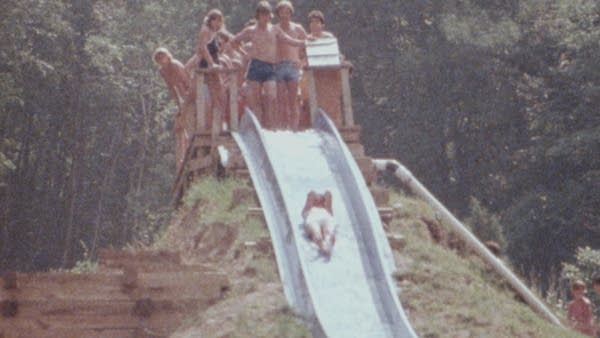David’s thoughts on “Class Action Park”
Econ Extra Credit newsletter #114

For the month of August, Econ Extra Credit invites you to view the film “Class Action Park,” which is available to stream on HBO Max with a subscription. We hope you’ll watch and then send us your thoughts, questions and stories. Reach us by email at extracredit@marketplace.org.
Torte is a layer cake involving whipped cream, mousse or jam. Tort is a system of laws that can give individuals the power to win damages from businesses that hurt them and to deter organizations from doing dangerous things. Watching this month’s documentary, “Class Action Park,” I was left shaking my head, wondering how many safety-related lawsuits could be brought against an amusement and water park before it has to close altogether. Action Park in New Jersey did eventually go out of business, but the cause of death seems more related to financial impropriety than lawsuits.
Another phrase from the legal books is “attractive nuisance,” which is defined by the Legal Information Institute at Cornell as “a dangerous condition on a landowner’s property that may particularly attract children onto the land and pose a risk to their safety.” If the conditions depicted in the film are accurate, this facility, which flourished in the 1980s, was an industrial-grade attractive nuisance that played a role in a stream of injuries, some serious, some fatal.

There was a custom-designed loop-the-loop water tube that claimed a lot of teeth. There was a kind of luge course from hell that claimed a lot of skin and some bones. A wave pool with multiple drownings. And these were just some of the attractions. I use the word “attractions” because it appears that many a young New Jersey kid would actively seek out the possibility of danger at this janky-seeming place. Why state regulators did not work harder to beef up safety in a park where attractions had a kind of Niagara-Falls-in-a-pickle-barrel sensibility remains a mystery to me.
When park guests were hurt or killed, the film tells us park ownership took a hard line against settling lawsuits, preferring instead to be taken to court. These days if you get hurt at a park through no fault of your own, there are plenty of law firms ready to sue, with payment of legal bills to be drawn from any awards. Where was this system in Action Park’s heyday?
What little knowledge I have about personal injury suits was acquired at the American Museum of Tort Law. (It exists. It’s in Connecticut. Consumer advocate Ralph Nader is its champion.) There’s this display about a 1973 Florida case concerning a man who died when his car hit a truck — the court deemed him partially at fault. Before this case, even being slightly at fault meant the family could get no money. However, this case embraced what is called “comparative negligence,” the notion an injured party may still be entitled to some damages — although reduced by some level — even if they were partially at fault.
I spoke to a law professor in Minnesota who teaches an entire course focused on the lessons of Action Park. Bill Childs at Mitchell Hamline School of Law told me comparative negligence has a flip side: While being unruly or foolish in a theme park doesn’t disqualify you from winning damages if you get hurt, your own conduct is relevant under the law too. The doc suggests Action Park managers were adept at interviewing people before they retained lawyers to capture evidence that the patron had been acting like a knucklehead at the time of the injury. A plaintiff’s lawyer might not want to take you on as a client if you have already admitted to acting foolishly around the time of the injury.
The film offers some explanation for why the park was reluctant to settle suits. Its liability insurance was fake. To avoid paying the insurance premiums for a $2.1 million policy that the state required, Action Park’s founder, Gene Mulvihill, set up his own unauthorized insurance company in the Cayman Islands. And without real insurance, he would have had to pay any settlement himself, since there was no deep-pocketed insurance company as a backstop. Despite Mulvihill pleading guilty to five counts of insurance-related fraud in 1985, he didn’t go to prison, nor did Action Park shut down.
Another reason the park may have survived as long as it did: The extent of the injuries on its grounds was not fully known. Yes, the place had a skin-scraping and muscle-bruising reputation, but hard data was not forthcoming, in part because New Jersey only requires parks to report deaths or “serious” injuries (and there’s no consensus on what counts as a serious injury). The documentary indicates only injuries that led to an ambulance ride were reported to authorities.
The Colorado Sun reported at least 11 skiers died during the 2020-21 season at more than two dozen resorts in that state. The paper cobbled together this grim number by consulting individual coroner offices because Colorado ski resorts do not have to share information on deaths or other accidents on their runs. Proposed legislation that would have required more disclosure of ski slope injuries did not make it through the Colorado General Assembly, even though publicizing injury rates could help skiers make better choices. While Action Park in New Jersey closed its doors in 1996, disclosure is still an issue for thrill seekers today.
“Class Action Park” is available to stream on HBO Max with a subscription. We hope you’ll watch and then send us your thoughts, questions and stories. Reach us by email at extracredit@marketplace.org.













